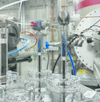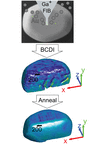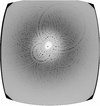issue contents
March 2021 issue

Cover illustration: Coherent X-ray diffraction pattern of three Ni nanoparticles aggregated on a thin Si3N4 membrane (see Ahn, Cho, Kim, Lee, Sung, Jung, Song, Kang and Noh, pages 505–511). A three-dimensional density map of the specimen was obtained through a phase retrieval process utilizing the diffraction patterns obtained at various sample orientations. The morphological change during oxidation could be investigated by monitoring the coherent X-ray diffraction pattern.
facility information
scientific commentaries
Open  access
access
 access
accessThe article by Zhu et al. [J. Synchrotron Rad. (2021), 28, 624–636] published in this journal issue presents the setup and specifications of the new soft X-ray beamline HIPPIE, dedicated to ambient-pressure X-ray photoelectron spectroscopy at the MAX IV Laboratory.
research papers
Open  access
access
 access
accessA new concept for temporal gating of synchrotron X-ray pulses based on laser-induced thermal transient gratings is presented.
The experimental results and theoretical approach presented here can be successfully applied to measure and to characterize transmission and focusing properties of different spherically bent microchannel plate devices having different radii of curvature for possible applications with synchrotron radiation.
The study of the interaction of synchrotron X-ray radiation with a multislit collimator is a critical factor for the creation of microbeams in radiation therapy. This study is a fundamental step forward in the understanding and definition of a reliable protocol for dosimetry at the micrometric scale to be used in microbeam radiation therapy.
The development of an undulator whose magnetic field profile can be arbitrarily varied is reported.
Open  access
access
 access
accessThe first microbeam irradiation study at the biomedical beamline SYRMEP of the Elettra-Sincrotrone Trieste, the technical setup of the experiment and the results of the associated cell culture study in murine melanoma cells are reported.
Open  access
access
 access
accessThe problem of X-ray beam nanofocusing with compound refractive lenses is examined in detail. It is shown that the minimum beam size is independent of either the aperture or photon energy but depends only on the compound refractive lens material electron density.
Design, implementation and results of characterization are reported for new synchrotron beamlines at Cornell High Energy Synchrotron Source featuring single-reflection X-ray monochromators with an interchangeable set of diamond crystals to provide monochromated beams at four different energies.
Open  access
access
 access
accessA Rigaku XSPA-500k detector was evaluated and its performance characterized on the Metrology beamline at Synchrotron SOLEIL together by the SOLEIL Detector Group, AGH-UST and Rigaku.
X-ray absorption near-edge structure (XANES) and extended X-ray absorption fine-structure (EXAFS) spectra were recorded to investigate the electronic structure and local crystal structure of ZnO and ZnO:B powders produced via hydrothermal synthesis. No disorder within the crystallographic structure of ZnO upon B doping has been observed by X-ray diffraction results which are supported by the EXAFS results.
A well designed compact furnace has been designed for in situ X-ray absorption spectroscopy at various temperatures up to 1473 K and under controlled atmosphere.
Methods are presented for fabricating a silicon microfluidic device that can be used to study, in situ, pore-scale geochemistry under flow conditions using X-ray fluorescence microprobe spectroscopy for elements as light as iron. Example results of an iron–arsenic sulfide geochemical system include X-ray fluorescence mapping, point XANES and multiple energy mapping, which highlight controls on arsenic transport because of sorption to iron solids and reactions of sulfide with iron solids that change arsenic sorption.
The design and operation of a 3D-printed flow in situ electrochemical cell suitable for ambient-temperature X-ray absorption spectra measurements is described. The ability to control, and significantly limit, photoreduction whilst requiring only small solution volumes make this a superior sampling approach to cryogenic techniques for many samples.
Integration of high crystalline structures of III–V semiconductors on Si and Ge is the prime requirement for the implementation of highly efficient and economically viable nano-photonic devices. EXAFS results of GaP/Ge(111) obtained using a synchrotron radiation source provided excellent insight and proposed new possibilities within the GaP/Ge hetero-structure, such as the conversion from indirect to direct band structures and engineering the tensile strain quantum dot structures on (111) surfaces.
Open  access
access
 access
accessContinuous sample translation is evaluated as a tool to reduce X-ray damage in X-ray photon correlation spectroscopy studies of protein diffusion.
A wave optics model is proposed to analyze the effect of partial coherence on coherent diffractive imaging for an actual beamline layout, based on the finite size of the source and the influence of optics on the wavefront.
Coherent X-ray diffraction imaging reveals the oxidation-induced nanoscale morphological changes of Ni nanoparticles in three dimensions non-destructively. The Ni particles were oxidized into Ni1O1 while forming pores of various sizes internally.
A bidirectional scanning method designed for scanning transmission X-ray microscopy (STXM) with an S-shaped moving track is presented. This work removes the limitations on bidirectional scanning caused by motor backlash and vibration, and significantly improves the efficiency of STXM experiments.
Open  access
access
 access
accessThe combination of small-angle X-ray scattering and X-ray holography enables us to visualize and characterize biological material in cell nuclei spanning multiple length scales.
A specific sample environment has been developed to enable highly controlled (temperature and strain rate) high-temperature deformation mechanical testing to be conducted while performing in situ tomography on a synchrotron beamline.
Open  access
access
 access
accessHow Compton scattering can reduce the real space resolution achievable with the Bragg coherent diffraction imaging technique is analysed.
Open  access
access
 access
accessAn in situ Bragg coherent X-ray diffraction annealing experiment on focused ion beam damaged gold microcrystals is presented.
This paper aims to develop a new method for training a deep neural network using synthetic data. The trained model will be used to automatically segment micro-CT images of bread dough collected at the Australian Synchrotron.
beamlines
Open  access
access
 access
accessA description of the 1-Megapixel pnCCD detector design and capabilities, its implementation at EuXFEL's Small Quantum Systems Instrument both mechanically and from the controls side as well as important data correction steps aim to provide useful background for users planning and analyzing experiments at EuXFEL and may serve as a benchmark for comparing and planning future endstations at other FELs.
Open  access
access
 access
accessThe transfer and upgrade of the SPECIES beamline and its endstation to the 1.5 GeV storage ring at the MAX IV Laboratory is reported.
BL-5C, a macromolecular crystallography beamline, at PLS-II has been upgraded to support automated and high-throughput data collection.
Open  access
access
 access
accessX-SPEC is a high-flux undulator beamline for electron and X-ray spectroscopy with an energy range from 70 eV to 15 keV. It offers X-ray absorption spectroscopy (XAS), extended X-ray absorption fine structure (EXAFS), photoelectron spectroscopy (PES) and hard X-ray PES (HAXPES), as well as X-ray emission spectroscopy (XES) and resonant inelastic X-ray scattering (RIXS) for in vacuo, in situ and operando sample environments.
A high-photon-flux beamline for research and development of new functional materials was constructed at BL07A of NewSUBARU by combining a 3 m undulator and a monochromator composed of three different multi-layered mirrors. The photon flux irradiating the irradiation point was determined from measurements using a photodiode to be more than 1013 photons s−1 cm−2 in the energy range 80–800 eV, which was sufficient for surface modification experiments using monochromatic light irradiation.
Open  access
access
 access
accessThe setup and specifications of the new soft X-ray beamline HIPPIE, dedicated to ambient-pressure X-ray photoelectron spectroscopy at the MAX IV Laboratory, are summarized. Several scientific examples are also discussed to prove the capabilities of the endstation.
Open  access
access
 access
accessThe Materials Imaging and Dynamics (MID) instrument at the European X-ray Free-Electron Laser facility is described. Recent commissioning results are discussed to illustrate the potential experimental applications of MID.
Open  access
access
 access
accessThe new Frontier Microfocus Macromolecular Crystallography beamline FMX in sector 17-ID-2 of the National Synchrotron Lightsource II provides an ultra-bright microfocus beam and a flexible experimental station for structure determination from the most challenging crystals.
addenda and errata
Free 

The weblinks for the Daresbury Laue software source code and information have become hidden from a simple google search. This Addendum makes clear where the software source code and information can now be found.
Free 

A correction to an equation in the paper by Zhukovsky [(2020). J. Synchrotron Rad. 27, 1648–1661] is made.


 journal menu
journal menu























































